Who benefits from the telecommunication masts?
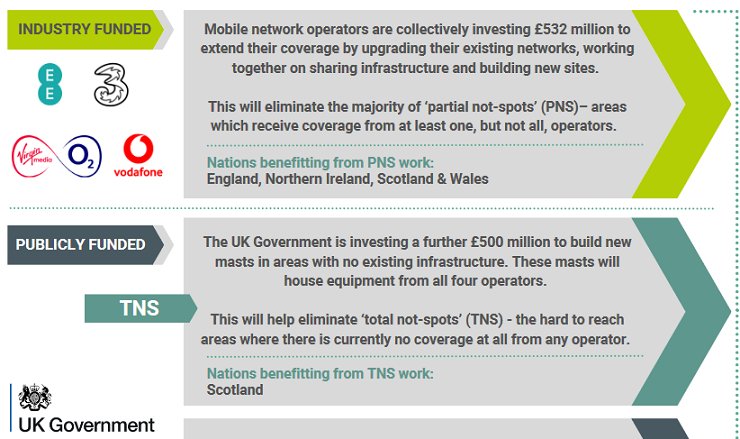
The spate of new telecommunications masts which, as George Allan from the North East Mountain Trust explained on Monday (see here), threaten some of Scotland’s finest landscapes are intended to eliminate “total not spots”. They form part of the Shared Rural Network programme and are being funded by the UK Government at a cost to the public purse of £500m.
While these “total not spots” include glens with rural communities that are accessible by public road, they also include remoter areas with no public vehicular access. In those areas the main people who could benefit from the masts are outdoor recreationists and large land-holdings, whether owned privately or by non/governmental organisations.
How much of the £500m is earmarked to address total not spots in these remoter areas has not been explained, but it is likely to be considerable due to the high construction and maintenance costs. The main beneficiaries will be the privileged few. Setting aside the adverse landscape and environmental impacts, are the wishes of outdoor recreationists who wish to navigate by GPS really more important than housing the homeless? £250m would build a significant number of new houses, including in rural areas.
As for people working in remote glens, there is not a large landowner in the country who could not afford to provide satellite phones.
Telecommunications masts and landowners
Under the Shared Rural Network process the developers have first looked for locations for masts, usually on a prominent raised are of hillside to maximise the coverage. “If a location is suitable, we
then engage with key stakeholders including landowners and local planning departments. During the planning process we will start negotiations with land owners to formally acquire the site and leases
are agreed.” (Mast Build Fact Sheet)
Legally telecommunications mast providers have powers to install and operate telecommunications masts without a landowners consent and to compulsorily purchase the land if necessary for a fairly nominal sum (see here for explanation). However, landowners still have the power to exert considerable influence over these developments, both because of how they control access to the land where a mast is situated and through the planning system .
A good example of this is the provisional objection registered by the Inverinate Estate to the Prior Notifications to erect a masts on their land including at the west end of Loch Mullardoch (Highland Council planning reference 23/04105/TPNO – for map see George Allan’s post):
“The Estate wish to lodge a ‘holding objection’ to each of these developments in order to be
afforded more time to properly consider the respective detail of each proposed development
before making final comments.
Although the Estate has no objections in principle to an improved telecommunications network
in both the immediate and wider area, on account of the very remote nature of their locations, it
has serious concerns regarding the potential impacts of each development on the efficient and
effective running and management of the Estate not only during the construction period, but
more significantly, in providing access and associated timings to accommodate maintenance to
these facilities in the future.”
This letter appears to have been intended to force the developer to the table. While the Inverinate Estate is quite happy to be provided with a telecommunications network at public expense, it appears to be trying to use its control over the 12.5km access route to extract further rent from the developers (which is ultimately paid for by the public in phone charges).
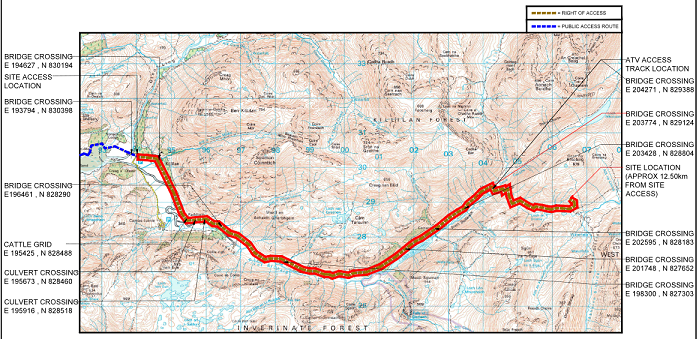 Just how 2 monthly servicing visits by ATV would impact on “the efficient and effective running of the estate” is unclear but faced with the option of a time-consuming and expensive court battle, the telecommunication mast providers are likely to cough up something.
Just how 2 monthly servicing visits by ATV would impact on “the efficient and effective running of the estate” is unclear but faced with the option of a time-consuming and expensive court battle, the telecommunication mast providers are likely to cough up something.
The converse side to this, however, is that if the Inverinate Estate had said it had no need for the improved communications because it used satellite phones, half the rationale for these masts would have disappeared. Couple that with the representation from Mountaineering Scotland that any benefits from increased phone provision would be outweighed by the adverse impact on the wild land experience and the case for these masts would collapse.#
While that would not have been enough in this case for Highland Council to refuse this particular masts – as its “only” in a Wild Land Area and is treated as permitted developments – objections from owners of land in protected areas, like the Glen Affric Scenic Area would potentially be enough to stop these developments. (An example is the mast, reference 23/04722/FULL, on land 1150M East ff Strawberry Cottage, Glen Affric).
More on the landscape and environmental impacts – the west Mullardoch example
 Many of the applications/prior notifications for these telecommunications masts contain little information to judge their impacts but that for the west end of Loch Mullardoch (Highland Ref 23/04105/TPNO does (see here)) – perhaps thanks to an objection from Mountaineering Scotland – so I will use that as an example.
Many of the applications/prior notifications for these telecommunications masts contain little information to judge their impacts but that for the west end of Loch Mullardoch (Highland Ref 23/04105/TPNO does (see here)) – perhaps thanks to an objection from Mountaineering Scotland – so I will use that as an example.
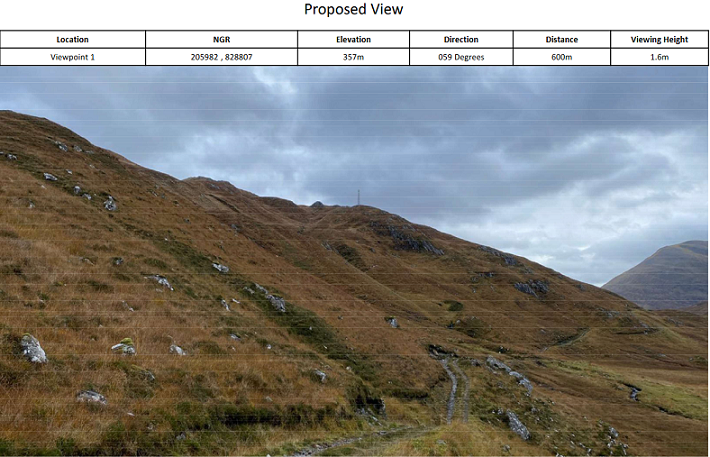
To maximise coverage in wild and rugged country the masts need to be in prominent locations. In terms of the recreational enjoyment of wild land, these could hardly be in worse locations.
That wild land experience is likely to be impacted further as the MOD requires that all these masts be fitted with aviation safety lighting:
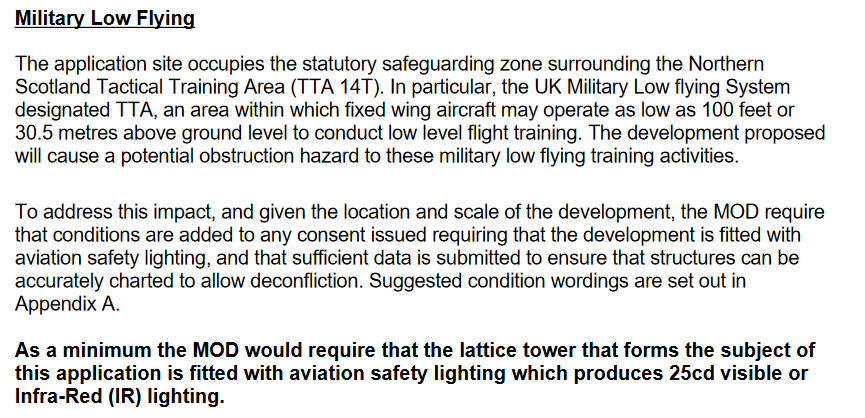 Visible lighting would impact on some of the best places in Scotland to enjoy dark skies.
Visible lighting would impact on some of the best places in Scotland to enjoy dark skies.
What’s dangerous for planes may also pose risks to golden eagles on days with thick mist.
The visual and environmental impacts will be increased further by the access tracks and this is given almost no consideration in the applications. The regular use of ATVs is likely to create permanent tracks up the hillsides to the prominent positions where they are to be located, churning up the ground and where there are peaty soils releasing lots of carbon into the atmosphere.
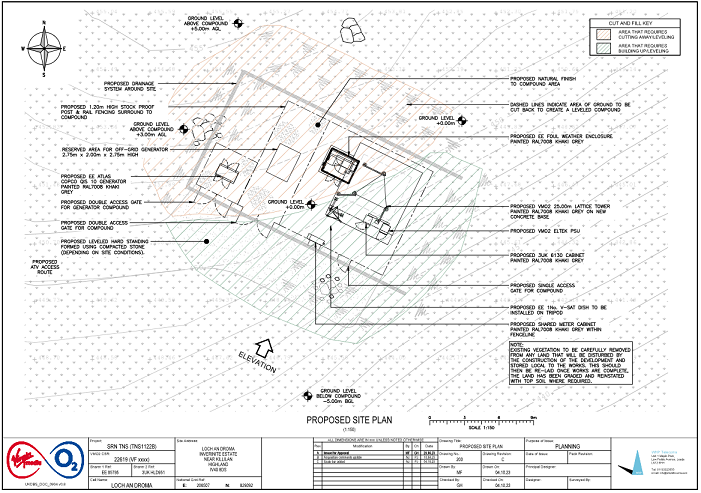 While locations such as that west of Loch Mullardoch this may be rarely visited at present, the masts and associated infrastructure will have a significant impact from close up. They require level ground, hence the proposals flatten and fill the area around the mast. Presumably heavy machinery will require to be brought in to do that. On top of that are the fences, cabinets and in this case a diesel generator.
While locations such as that west of Loch Mullardoch this may be rarely visited at present, the masts and associated infrastructure will have a significant impact from close up. They require level ground, hence the proposals flatten and fill the area around the mast. Presumably heavy machinery will require to be brought in to do that. On top of that are the fences, cabinets and in this case a diesel generator.

The carbon emissions associated with the construction and maintenance of masts like this in remote areas are considerable: the steel, the transport costs (the proposal is to fly construction materials in by helicopter), the diesel to operate the generator etc. That, along with the impact on the landscape, should be weighed against any of its alleged benefits. Its not in the public interest but yet again no expense seems to be spared when it comes to subsidising rich private landowners.
What could be done?
The coalition of organisations that have come together to try and halt these masts are doing valuable work in the background (lobbying, objecting to particular applications etc) and rightly urging for a far more strategic approach but there is a need for a far more public campaign.
This morning, for example, I checked the websites for Mountaineering Scotland, Ramblers Scotland and the Munro Society as well as the latest John Muir Trust newsletter and can find nothing obvious about what is happening or that calls on their members to take action. I appreciate that staff and volunteers (the Munro Society) are under huge pressure but the answer surely is for the organisations with paid staff to put more effort into mobilising those that value Scotland’s wild places to defend them, as the North East Mountain Trust has been trying to do.
While Mountaineering Scotland put in a robust objection to the west Mullardoch application, that from the John Muir Trust (I am a member of both and the Ramblers) starts as an apology: “It is with regret that we note our concerns………………”. That I suspect will hardly make the planners shudder at their desks.
At least JMT’s letter points out “No Wild Land Impact Assessment has been provided as per Policy 4(g) of the NPF4”. However, dealing with these applications in terms of the logic of a planning system which is stacked in favour of developers and development, even in Scotland’s wildest landscapes, will in my view at most stop or delay a handful of the applications. JMT has taken a fine campaigning stance on reducing numbers of red deer so why not also on telecommunications masts?
A far more public campaign is needed, such as the grassroots campaign that has developed against new overhead powerlines along the North East coast. If the coalition is to stop these masts, a good place to start in raising awareness might be to pressurise all the landowners who have been tacitly supporting these applications to date.
Perhaps the £500 million could be used to fund the much vaunted Scottish space industry to come up with a few satellites to be launched from all the new space ports. Maybe subsidise low income users.
The campaigning so far has certainly been low-key. i suspect organisations are worried that strident campaigning might offend a chunk of their membership. For various reasons I am only now getting round to looking at the applications, although I’ve known for a while that they were on the horizon. Actually, from what I’ve seen so far, the window for objections has already closed in some cases (although THC website still accepts comments). I admit I had no idea things were so far advanced. It’s horrifying. I wonder how many hill goers realise this?
It looks as though comments can still be submitted in cases where the application has not yet been determined. The application to put a mast on the slopes of Ben Oss has been withdrawn (7th November, so very recent). Invercauld Estate and the people of Ballater objected strongly to having one on their land/in their area, but were overruled. (I gather the applicant removed the new stretch of access track they had planned to put in and made some other changes that won the planners over … yeah, it doesn’t take much.) Iron Lodge and Glensherro Lodge are still under consideration, as is Glen Affric/Strawberry Cottage.
Thanks Nick. I can re-assure you that JMT has been campaigning on this issue. We and our partners, particularly Mountaineering Scotland and the Knoydart Foundation as well as all the other partners in the coalition have:
1. Written to and met with phone operators; 2. written to Offcom; 3. written to and met with local council planning officials; 4. Written to and met with UK govt. officials; 5. Written to and met with UK MPs – one of whom is currently assisting in drafting and submitting PQs. ; 6. Sent press releases and briefed journalists. 7. Monitored and objected to a number of completely inappropriate masts: https://www.johnmuirtrust.org/resources/1566-shared-rural-network-have-your-say and 8. Asked our members to help: https://www.johnmuirtrust.org/resources/1566-shared-rural-network-have-your-say
Thanks Mike, I know JMT and others have been doing things – and am not questioning the need for a strategic approach – but awareness of what is happening appears very low and without large scale public support all that effort will be wasted. I am as at much fault as others here and will now try and raise awareness of what is happening in our National Parks
Nick: I think the political background is not ‘benefitting rich landowner’s but the Levelling-Up programme, and a need for UKGov to to ‘do something for Scotland’ in a colonial way. This is why the SRN programme has not been allowed time to plan properly, put the masts in places where they are wanted, and avoid unnecessary damage to sensitive areas like Wild Land. Incidentally the developers seem unaware of Wild Land as as issue, perhaps because this is not a concept in England and the programme is being run from Whitehall.
“4G coverage to 95% of the UK landmass by 2025”
So SGgov is deliberately sidelined, and the only local lever is Planning. Planners are faced with a deluge of applications in areas the planners themselves will know little about : precious and fragile Wild Land, rarely visited but which needs protection from blundering interventions like this. COVID enquiry shows the shambolic way Gov policies are thought-up and implemented; I don’t think they have clue about the long term damage which the access tracks will cause. Once the network operators have spent the SRN capital grants and pocketed the profits, they will no doubt quietly lose interest in maintaining these masts with 2-monthly refuelling ATV visits (in winter?), particularly when 4G is superceded in a few year’s time. Even if they remove redundant masts (?) the scars will remain.
I don’t think hillwalkers in these areas should be encouraged to use 4G for navigation. Download maps into your phone memory and use the GPS signal from space; use your phone sparingly to preserve battery life; and realise there will always be not-spots in rugged terrain. Anyhow, ‘No Signal’ is part of the Wilderness experience. Do we want chairlifts up every Munro, to make them more accessible and enjoyable?
I think the grants work out at ~£1M per mast.